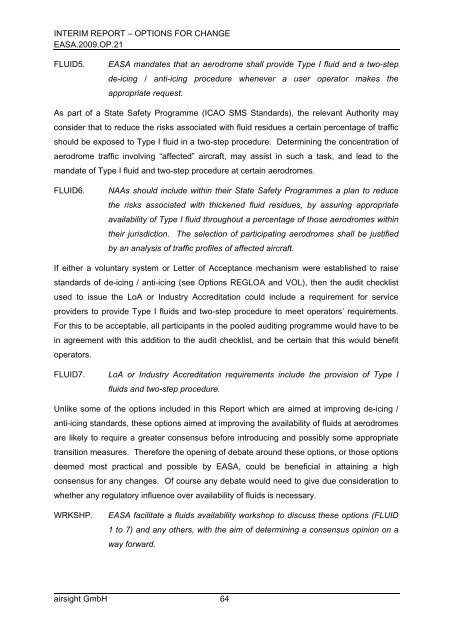Interim Report - Introduction - EASA
Interim Report - Introduction - EASA
Interim Report - Introduction - EASA
You also want an ePaper? Increase the reach of your titles
YUMPU automatically turns print PDFs into web optimized ePapers that Google loves.
INTERIM REPORT – OPTIONS FOR CHANGE<br />
<strong>EASA</strong>.2009.OP.21<br />
FLUID5. <strong>EASA</strong> mandates that an aerodrome shall provide Type I fluid and a two-step<br />
de-icing / anti-icing procedure whenever a user operator makes the<br />
appropriate request.<br />
As part of a State Safety Programme (ICAO SMS Standards), the relevant Authority may<br />
consider that to reduce the risks associated with fluid residues a certain percentage of traffic<br />
should be exposed to Type I fluid in a two-step procedure. Determining the concentration of<br />
aerodrome traffic involving “affected” aircraft, may assist in such a task, and lead to the<br />
mandate of Type I fluid and two-step procedure at certain aerodromes.<br />
FLUID6. NAAs should include within their State Safety Programmes a plan to reduce<br />
the risks associated with thickened fluid residues, by assuring appropriate<br />
availability of Type I fluid throughout a percentage of those aerodromes within<br />
their jurisdiction. The selection of participating aerodromes shall be justified<br />
by an analysis of traffic profiles of affected aircraft.<br />
If either a voluntary system or Letter of Acceptance mechanism were established to raise<br />
standards of de-icing / anti-icing (see Options REGLOA and VOL), then the audit checklist<br />
used to issue the LoA or Industry Accreditation could include a requirement for service<br />
providers to provide Type I fluids and two-step procedure to meet operators’ requirements.<br />
For this to be acceptable, all participants in the pooled auditing programme would have to be<br />
in agreement with this addition to the audit checklist, and be certain that this would benefit<br />
operators.<br />
FLUID7. LoA or Industry Accreditation requirements include the provision of Type I<br />
fluids and two-step procedure.<br />
Unlike some of the options included in this <strong>Report</strong> which are aimed at improving de-icing /<br />
anti-icing standards, these options aimed at improving the availability of fluids at aerodromes<br />
are likely to require a greater consensus before introducing and possibly some appropriate<br />
transition measures. Therefore the opening of debate around these options, or those options<br />
deemed most practical and possible by <strong>EASA</strong>, could be beneficial in attaining a high<br />
consensus for any changes. Of course any debate would need to give due consideration to<br />
whether any regulatory influence over availability of fluids is necessary.<br />
WRKSHP. <strong>EASA</strong> facilitate a fluids availability workshop to discuss these options (FLUID<br />
1 to 7) and any others, with the aim of determining a consensus opinion on a<br />
way forward.<br />
airsight GmbH 64

















